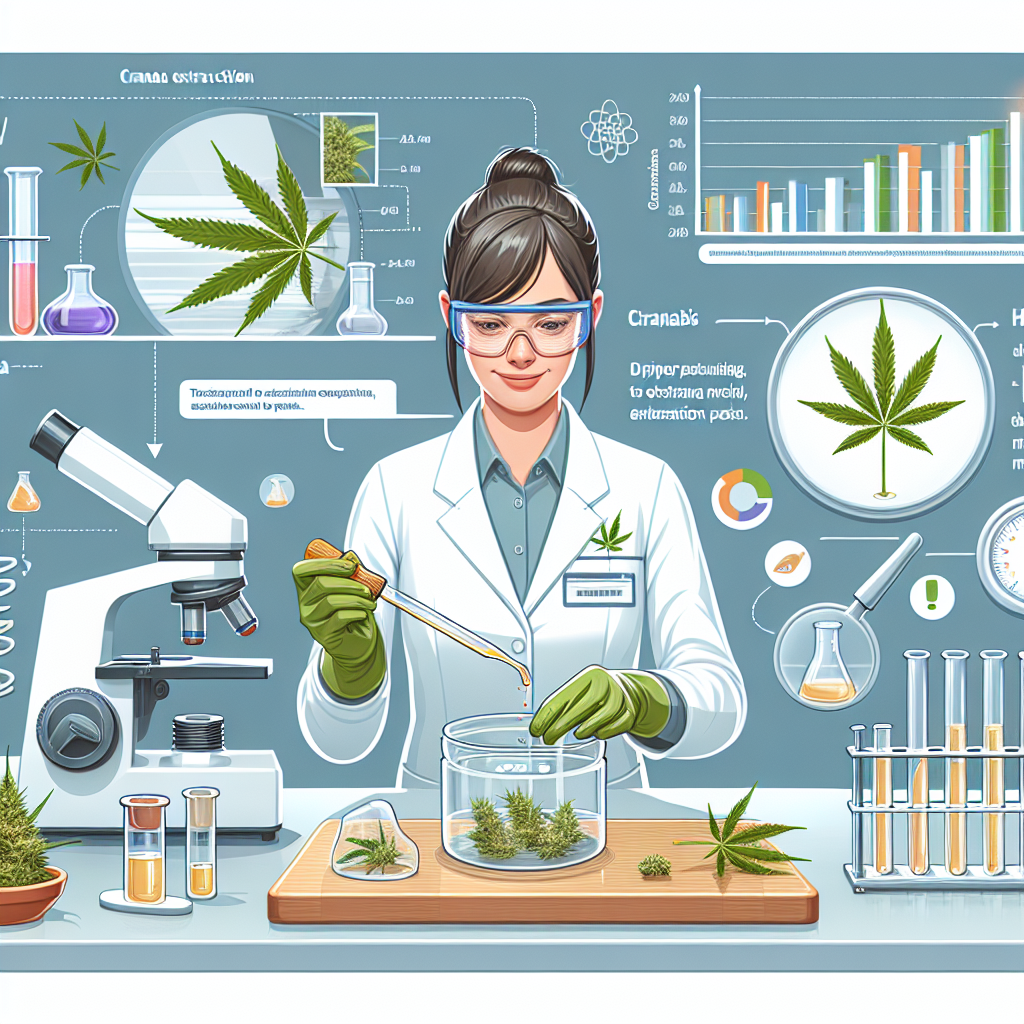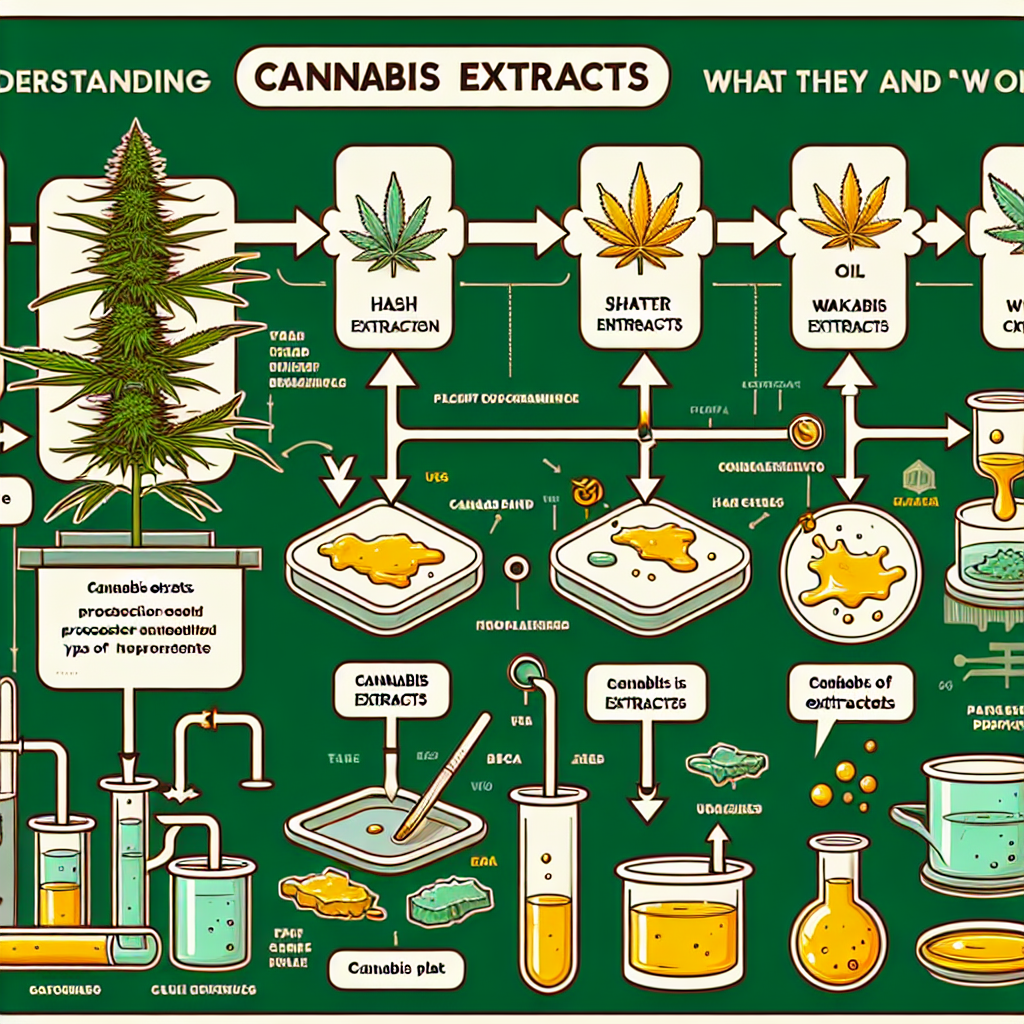Cannabis extracts have become increasingly popular as the cannabis industry evolves, offering a range of products that cater to both medicinal and recreational users. Understanding these extracts is crucial for consumers looking to make informed choices. Cannabis extracts are concentrated forms of the plant’s active compounds, primarily cannabinoids like THC and CBD, and terpenes, which contribute to the plant’s aroma and effects. These extracts are created through various extraction methods, such as CO2 extraction, ethanol extraction, and hydrocarbon extraction, each with its own advantages and potential drawbacks. The resulting products can vary widely in potency, consistency, and application, from oils and tinctures to waxes and shatters. By comprehending the different types of cannabis extracts and their mechanisms of action, users can better navigate the diverse landscape of cannabis products and tailor their consumption to their specific needs and preferences.
The Basics Of Cannabis Extracts: An Introduction
Cannabis extracts have become increasingly popular in recent years, captivating the interest of both seasoned enthusiasts and curious newcomers. To understand what cannabis extracts are and how they work, it’s essential to start with the basics. At its core, a cannabis extract is a concentrated form of the plant’s active compounds, primarily cannabinoids and terpenes. These extracts are created through various methods that isolate these compounds from the plant material, resulting in a potent product that can be used in multiple ways.
One of the most common cannabinoids found in cannabis extracts is THC, or tetrahydrocannabinol, which is responsible for the plant’s psychoactive effects. Another key cannabinoid is CBD, or cannabidiol, known for its potential therapeutic benefits without the high. Terpenes, on the other hand, are aromatic compounds that contribute to the plant’s unique scent and flavor profile. They also play a role in the entourage effect, where the combination of cannabinoids and terpenes work synergistically to enhance the overall experience.
The process of creating cannabis extracts can vary, but it generally involves using a solvent to separate the desired compounds from the plant material. Solvents like ethanol, butane, and CO2 are commonly used, each with its own advantages and drawbacks. For instance, CO2 extraction is praised for its ability to produce a clean and pure product without leaving behind harmful residues. Conversely, butane extraction, while effective, requires careful handling to ensure safety and purity.
Once the extraction process is complete, the resulting product can take several forms, including oils, tinctures, shatter, wax, and more. Each form has its own unique properties and uses. For example, cannabis oils and tinctures are often consumed sublingually, allowing for quick absorption into the bloodstream. Shatter and wax, on the other hand, are typically vaporized or dabbed, providing a more immediate and intense effect.
Understanding how cannabis extracts work involves delving into the body’s endocannabinoid system (ECS). The ECS is a complex network of receptors and enzymes that play a crucial role in maintaining homeostasis, or balance, within the body. When cannabinoids from cannabis extracts interact with the ECS, they can influence various physiological processes, such as pain perception, mood regulation, and immune response. This interaction is what underlies the potential therapeutic benefits of cannabis extracts, making them a subject of growing interest in medical research.
Moreover, the method of consumption can significantly impact the effects of cannabis extracts. Inhalation methods, such as vaping or dabbing, provide rapid onset of effects, making them suitable for those seeking immediate relief. Oral consumption, including edibles and capsules, results in a slower onset but longer-lasting effects, which can be beneficial for sustained symptom management. Topical applications, like creams and balms, target localized areas and are often used for pain and inflammation relief without producing systemic effects.
As the cannabis industry continues to evolve, so too does the variety and sophistication of cannabis extracts available. Innovations in extraction techniques and product formulations are constantly emerging, offering consumers more options than ever before. Whether you’re interested in the potential health benefits or simply curious about the different ways to enjoy cannabis, understanding the basics of cannabis extracts is a valuable first step. By familiarizing yourself with the various forms, extraction methods, and ways they interact with the body, you can make more informed choices and fully appreciate what these potent products have to offer.
Different Types Of Cannabis Extracts And Their Uses

Cannabis extracts have become increasingly popular as more people explore the diverse ways to experience the benefits of cannabis. These extracts are concentrated forms of the plant, offering a potent and versatile means of consumption. Understanding the different types of cannabis extracts and their uses can help you make informed decisions about which products might be best suited to your needs.
One of the most common types of cannabis extracts is hash, which has been used for centuries. Hash is made by compressing the resin glands, or trichomes, of the cannabis plant into a solid form. This process results in a product that is rich in cannabinoids and terpenes, providing a robust and flavorful experience. Hash can be smoked, vaporized, or even used in cooking, making it a versatile option for many users.
Moving on, we have kief, which is essentially the loose trichomes that fall off the cannabis flower. Kief is often collected using a grinder with a special compartment designed to catch these potent particles. While kief can be sprinkled on top of a bowl or joint to enhance its potency, it can also be pressed into hash or used to make other types of extracts.
Another popular extract is cannabis oil, which is created by using a solvent to extract the cannabinoids and terpenes from the plant material. The solvent is then evaporated, leaving behind a thick, sticky oil. Cannabis oil can be consumed in various ways, including sublingually (under the tongue), added to food or beverages, or used in vape pens. This versatility makes cannabis oil a favorite among many users, particularly those seeking a discreet and convenient method of consumption.
Shatter is another type of cannabis extract that has gained popularity in recent years. This brittle, glass-like substance is created through a process that involves purging the solvent from the extract at low temperatures. The result is a highly potent product that can be vaporized or dabbed. Dabbing involves using a specialized rig to heat the shatter and inhale the vapor, providing a fast-acting and intense experience.
Wax is similar to shatter but has a different consistency due to the way it is processed. Instead of being brittle, wax has a softer, more pliable texture. This makes it easier to handle and use, particularly for those who prefer dabbing. Like shatter, wax is highly potent and provides a powerful experience for users.
Live resin is another type of cannabis extract that has gained traction in the market. This extract is made using fresh, flash-frozen cannabis plants, which helps to preserve the delicate terpenes that can be lost during the drying and curing process. The result is a flavorful and aromatic product that offers a more authentic representation of the plant’s original profile. Live resin can be vaporized, dabbed, or used in various other ways, making it a versatile option for those seeking a high-quality experience.
Finally, we have tinctures, which are liquid cannabis extracts made by soaking the plant material in alcohol or another solvent. Tinctures are typically consumed sublingually, allowing for fast absorption into the bloodstream. They can also be added to food or beverages for a more gradual onset of effects. Tinctures are popular among medical cannabis users due to their precise dosing and ease of use.
In conclusion, the world of cannabis extracts offers a wide range of options for users to explore. From traditional hash and kief to modern innovations like shatter and live resin, there is something for everyone. By understanding the different types of extracts and their uses, you can find the perfect product to suit your needs and preferences.
The Science Behind Cannabis Extracts: How They Work In The Body
Cannabis extracts have gained significant attention in recent years, not only for their potential therapeutic benefits but also for their complex interaction with the human body. To understand how these extracts work, it is essential to delve into the science behind them. Cannabis extracts are concentrated forms of the plant’s active compounds, primarily cannabinoids and terpenes. These compounds interact with the body’s endocannabinoid system (ECS), a complex cell-signaling system that plays a crucial role in maintaining homeostasis, or balance, within the body.
The ECS consists of three main components: endocannabinoids, receptors, and enzymes. Endocannabinoids are naturally occurring compounds in the body that are similar to the cannabinoids found in cannabis. The two primary endocannabinoids are anandamide and 2-arachidonoylglycerol (2-AG). These molecules bind to cannabinoid receptors, which are found throughout the body. The two main types of receptors are CB1 and CB2. CB1 receptors are predominantly located in the brain and central nervous system, while CB2 receptors are mainly found in the peripheral organs and immune cells. Enzymes are responsible for breaking down endocannabinoids once they have fulfilled their function.
When cannabis extracts are consumed, the cannabinoids within them, such as tetrahydrocannabinol (THC) and cannabidiol (CBD), interact with the ECS. THC is known for its psychoactive effects, which occur because it binds strongly to CB1 receptors in the brain. This binding alters neurotransmitter release, leading to the characteristic “high” associated with cannabis use. On the other hand, CBD does not produce a high because it does not bind directly to CB1 or CB2 receptors. Instead, it influences the ECS by inhibiting the enzymes that break down endocannabinoids, thereby increasing their levels and prolonging their effects.
Moreover, the interaction between cannabinoids and the ECS can have various therapeutic effects. For instance, THC’s activation of CB1 receptors can help alleviate pain and stimulate appetite, making it beneficial for patients undergoing chemotherapy. CBD’s modulation of the ECS has been shown to reduce inflammation, anxiety, and seizures, which is why it is often used in the treatment of conditions like epilepsy and anxiety disorders. Additionally, the entourage effect, a phenomenon where cannabinoids and terpenes work synergistically, can enhance the overall therapeutic potential of cannabis extracts.
Transitioning to the topic of terpenes, these aromatic compounds also play a significant role in how cannabis extracts work in the body. Terpenes are responsible for the distinct smell and flavor of cannabis and can influence the effects of cannabinoids. For example, myrcene, a common terpene in cannabis, has sedative properties and can enhance THC’s psychoactive effects. Conversely, limonene, another prevalent terpene, has uplifting and anti-anxiety properties. The combination of cannabinoids and terpenes in cannabis extracts can create a tailored experience, depending on the desired therapeutic outcome.
In conclusion, the science behind cannabis extracts and their interaction with the body is intricate and fascinating. By engaging with the endocannabinoid system, cannabinoids like THC and CBD can produce a wide range of effects, from pain relief to anxiety reduction. Terpenes further modulate these effects, contributing to the unique characteristics of different cannabis strains. As research continues to uncover the complexities of the ECS and the potential benefits of cannabis extracts, it becomes increasingly clear that these natural compounds hold significant promise for improving human health and well-being.
Safety And Quality: What To Look For In Cannabis Extracts
When it comes to cannabis extracts, ensuring safety and quality is paramount. As the popularity of these products continues to rise, consumers must be well-informed about what to look for to make safe and effective choices. The first step in evaluating the safety and quality of cannabis extracts is understanding the source of the cannabis itself. High-quality extracts begin with high-quality cannabis plants, which should be grown without the use of harmful pesticides or chemicals. Organic cultivation methods are often preferred, as they minimize the risk of contaminants that could compromise the safety of the final product.
Another critical factor to consider is the extraction method used to produce the cannabis extract. There are several methods, including CO2 extraction, ethanol extraction, and hydrocarbon extraction, each with its own set of advantages and potential drawbacks. CO2 extraction is widely regarded as one of the safest and most efficient methods, as it uses carbon dioxide under high pressure and low temperatures to extract cannabinoids and terpenes without leaving behind harmful residues. Ethanol extraction is also considered safe when done correctly, but it requires careful handling to ensure that no residual solvents remain in the final product. Hydrocarbon extraction, which uses solvents like butane or propane, can produce highly potent extracts but carries a higher risk of residual solvents if not properly purged.
In addition to the extraction method, the purity and potency of the cannabis extract are crucial indicators of quality. Reputable manufacturers will provide lab test results that verify the cannabinoid content, terpene profile, and the absence of contaminants such as pesticides, heavy metals, and residual solvents. These lab reports, often referred to as Certificates of Analysis (COAs), should be readily available to consumers and conducted by third-party laboratories to ensure impartiality. When reviewing a COA, it’s essential to check that the levels of THC and CBD match what is advertised on the product label and that the extract is free from harmful substances.
The consistency and appearance of the cannabis extract can also offer clues about its quality. High-quality extracts should have a uniform texture and color, free from any visible impurities or inconsistencies. For example, a well-made shatter should be clear and glass-like, while a quality wax should have a smooth, buttery consistency. Any signs of cloudiness, discoloration, or unexpected textures could indicate that the extract was not processed correctly or contains unwanted contaminants.
Packaging and storage are additional aspects that can impact the safety and quality of cannabis extracts. Proper packaging should protect the extract from light, air, and moisture, all of which can degrade the product over time. Many high-quality extracts are packaged in airtight, opaque containers to preserve their potency and freshness. It’s also important to store cannabis extracts in a cool, dark place to prevent degradation and maintain their efficacy.
Finally, consumer education and responsible use play a significant role in ensuring the safe consumption of cannabis extracts. Understanding the proper dosage and potential effects of different extracts can help users avoid adverse reactions and maximize the therapeutic benefits. It’s always advisable to start with a low dose and gradually increase it as needed, paying close attention to how the body responds.
In conclusion, ensuring the safety and quality of cannabis extracts involves a combination of factors, including the source of the cannabis, the extraction method, lab testing, product consistency, packaging, and responsible use. By being informed and vigilant, consumers can make confident choices and enjoy the benefits of cannabis extracts safely and effectively.
Q&A
1. **What are cannabis extracts?**
Cannabis extracts are concentrated forms of cannabis that contain high levels of cannabinoids, such as THC and CBD, obtained through various extraction methods like CO2 extraction, ethanol extraction, or hydrocarbon extraction.
2. **How are cannabis extracts typically consumed?**
Cannabis extracts can be consumed in several ways, including vaporization, dabbing, adding to edibles, or using tinctures and topicals.
3. **What are the benefits of using cannabis extracts?**
The benefits of using cannabis extracts include higher potency, faster onset of effects, precise dosing, and the ability to isolate specific cannabinoids for targeted therapeutic effects.
4. **What are the potential risks associated with cannabis extracts?**
Potential risks include overconsumption due to high potency, contamination from residual solvents or pesticides, and adverse reactions such as anxiety or paranoia, especially in inexperienced users.
Conclusion
Cannabis extracts are concentrated forms of the active compounds found in the cannabis plant, primarily cannabinoids like THC and CBD, as well as terpenes and flavonoids. These extracts are produced through various methods such as solvent extraction, CO2 extraction, and mechanical separation. They offer a more potent and targeted way to consume cannabis, allowing for precise dosing and a range of consumption methods including vaping, edibles, tinctures, and topicals. Understanding cannabis extracts involves recognizing their different types, such as oils, waxes, shatters, and distillates, each with unique properties and uses. The efficacy and effects of these extracts depend on their composition, the method of consumption, and individual user factors. As the cannabis industry evolves, extracts continue to play a significant role in both medicinal and recreational use, offering versatile and potent options for consumers.


